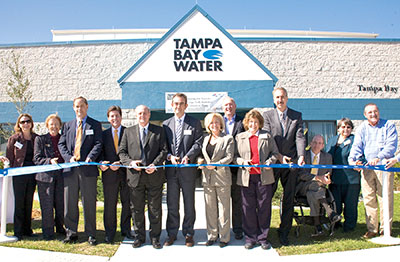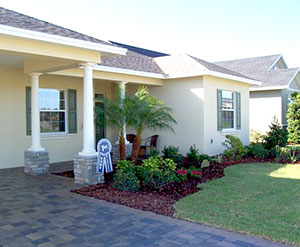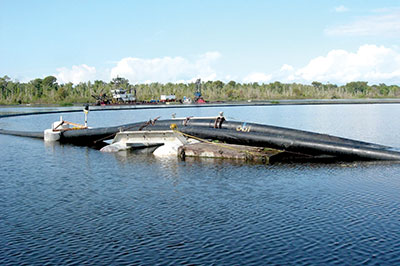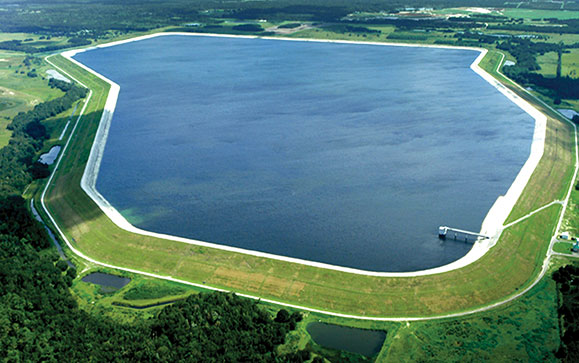The C.W. “Bill” Young Regional Reservoir is the result of the historic Partnership Agreement, which sought to reduce groundwater pumping in the regional wellfields by developing alternative water supplies.
While much of the 1990s was characterized by the contentious “water wars” and the signing of the historic Partnership Agreement, the 2000s ushered in a decade of regional cooperation focused on solving the area’s greatest water supply challenges through the development of large-scale alternative water supply projects.
As a result of decades of groundwater overpumping, the District focused its efforts on restoring water resources in the Northern Tampa Bay area and the Southern Water Use Caution Area.
Water Supply Development
The first piece in the Tampa Bay water supply puzzle was put into place in 2002 with the completion of the 66-million-gallon-per-day (mgd) surface water treatment plant and interconnecting pipelines, followed by the completion of the $146 million C.W. “Bill” Young Regional Reservoir in 2005. Located in southern Hillsborough County, the 15-billion-gallon reservoir can provide 25 percent of the region’s drinking water for more than six months and helped Tampa Bay Water begin reducing the amount of water pumped from the regional wellfields. The District contributed $26 million in Florida Forever funding toward the purchase of 5,515 acres, in cooperation with Tampa Bay Water, to build the 1,100-acre reservoir. The property is now the District’s Chito Branch Reserve.

Tampa Bay Water’s Tampa Bay Seawater Desalination Plant remains the largest seawater desalination plant in North America.
In 2008, Tampa Bay Water’s Tampa Bay Seawater Desalination Plant in Apollo Beach became fully operational, with the ability to provide up to 25 mgd of drinking water. As the largest seawater desalination plant in North America, the plant can provide up to 10 percent of the Tampa Bay region’s drinking water supply. In accordance with the Partnership Agreement, the District contributed $85 million plus $10.34 million in interest once all of the plant’s milestones were met.
In 2011, Tampa Bay Water is scheduled to complete an expansion of the surface water system that will add an additional 25 mgd of supply. This expansion will enable additional water to be withdrawn from the Hillsborough River and Tampa Bypass Canal during high-flow periods by increasing pumping capacity at existing pump stations, adding two new pump stations and increasing the surface water treatment capacity to 99 mgd. The District provided $105 million of cooperative funding toward the expansion in addition to $22 million in state funding.
“With the reservoir, desal plant and surface water treatment plant in place, the Tampa Bay area now has one of the most diverse water supply systems in the world,” said Ken Herd, water supply program director. “By utilizing traditional groundwater with a mix of alternative sources such as reclaimed, surface and desalinated water, we now have enough water supplies to meet the needs of the region’s residents for 20 years while achieving much-needed environmental recovery.”
The Peace River Manasota Regional Water Supply Authority also completed its six-billion-gallon reservoir and expanded its treatment facilities in 2009 at the District’s RV Griffin Reserve in DeSoto County. The reservoir, which captures excess flows from the Peace River, serves the residents of Charlotte, Sarasota and DeSoto counties. The District contributed more than $28 million toward the project as well as nearly $16 million from the state Water Protection and Sustainability Trust Fund.
The first phase of the Northern Tampa Bay recovery was completed in 2010 when Tampa Bay Water successfully reduced regional wellfield pumping to 90 mgd. Later that year, the Governing Board adopted the Phase 2 Recovery Rules. The second phase of the recovery will encompass 10 years, during which the effect of wellfield withdrawals at 90 mgd will be evaluated.
“Our legacy is that we substantially solved the water supply problem,” said David Moore, District executive director from 2003 to 2011. “We’ve got adequate water supplies through 2030 and laid the groundwork to get out to 2050 while restoring the natural systems.”
SWUCA Recovery Strategy
Nearly a decade of public workshops, water resource analyses, and policy debates culminated with the Governing Board approving the Southern Water Use Caution Area (SWUCA) Recovery Strategy in 2006, which outlined the District’s strategy for ensuring that adequate water supplies will be available to meet growing demands, while at the same time protecting and restoring the water and related natural resources of the area.
Throughout the decade, the District embarked on a number of projects and initiatives to help meet the goals of the recovery strategy by 2025, including establishing the Facilitating Agricultural Resource Management Systems (FARMS) Program, restoring lakes along the Lake Wales Ridge and developing the Lake Hancock Lake Level Modification Project to meet the minimum flows in the upper Peace River.
“Although we’ve laid the groundwork for the SWUCA recovery, this is still a long-term problem that we will need to continue focusing our attention on,” said Richard Owen, Regulation Division interim director. “While we’ve been able to reduce the rate of saltwater intrusion in the coastal counties, saltwater entering the aquifer will still present a long-term water supply challenge.”

The District encourages outdoor water conservation by partnering with the University of Florida’s Institute of Food and Agricultural Sciences to promote Florida-Friendly LandscapingTM.
Conservation Programs
Another way the District sought to solve the region’s water supply challenges was to develop a number of core conservation programs.
In September 2002, The District launched the Water Conservation Hotel and Motel Program (Water CHAMPSM) as a pilot project in the Pinellas-Anclote River Basin to encourage hotels and motels along the beaches to conserve water. The linen and towel reuse program quickly expanded Districtwide and the corresponding Water Program for Restaurant Outreach (Water PROSM) was added in 2008.
In order to finally shed the “rocks and cactus” perception that was associated with “Xeriscape,” the District partnered with the University of Florida’s Institute of Food and Agricultural Sciences in 2004 to promote Florida-Friendly LandscapingTM. The program emphasizes nine easy-to-accomplish principles that, when practiced, can conserve water and reduce pollution in our water bodies.
In 2009, Florida Water StarSM was launched as a voluntary certification program for builders, developers and homeowners to encourage water efficiency in appliances, plumbing fixtures, irrigation systems and landscapes.

The Lake Panasoffkee restoration project removed 8.3 million cubic yards of sediment from the lake.
Northern District Projects
Two major projects were completed in the northern portion of the District: the Wysong-Coogler Water Conservation Structure and the Lake Panasoffkee restoration project.
The original Wysong structure was built in 1965 to help conserve water in Lake Panasoffkee, the Withlacoochee River and the Tsala Apopka Chain of Lakes during the dry season. The structure was in place until 1988 when it became irreparable. In 1999, the Withlacoochee River Basin Board directed staff to replace the structure. The new structure was completed in 2002 and was renamed the Wysong-Coogler Water Conservation Structure in honor of Monroe “Al” Coogler, a former Governing Board member who was instrumental in getting the replacement structure built.
In 2008, the District completed the largest construction project ever undertaken by the agency. The $26.9 million, 10-year Lake Panasoffkee project restored the lake’s shoreline and historic fish bedding areas by removing approximately 8.3 million cubic yards of sediment from more than 1,744 acres of lake area. The project also improved navigation of the third largest lake in west-central Florida.
According to Mike Holtkamp, Operations, Maintenance & Construction Division director, the two projects have helped regulate water levels and improve the ecological health of the lake.
“The construction of the Wysong-Coogler structure has allowed the District to more reliably divert flows from the Withlacoochee River into the Tsala Apopka Chain of Lakes and to exercise control over water levels on Lake Panasoffkee,” said Holtkamp. “And all indications to date are that the restoration project has been a tremendous success: the water is clearer, eelgrass is thicker and fisheries are richer.”
The Future
Although the current economic climate and budget reductions will likely play a major role in shaping the immediate future of the agency, long-term water supply development, resource restoration and emerging water quality issues will continue to present challenges for the District to solve.

